Peach and nectarine production
Learn about site selection, planning systems, production, harvesting, grading and insects and diseases of peach and nectarine production.
Site, selection and planting systems
Site and selection
Criteria
- Temperatures — minimum: -4° F to -13° F (-20° C to -13° C)
- Precipitation: approximately 30 inches (900 mm) annually, spread over season
- Soil should be a deep, fine sandy loam soil with good soil drainage
- High in organic matter from cover crops or other soil amendments
- Tile drainage every row to reduce any standing water
- Fumigate for root lesion and dagger nematodes where necessary
- Soil testing prior to planting to correct any nutrient deficiencies
- Soil pH 6.5 + or -
Planting systems (North to South row direction)
1. Open center
- 155 trees per acre (20 x 14 feet)
- Not labour efficient — more ladder work for pruning, thinning and harvesting
- Early years have very low yields per acre
- Yields peak in 6th to 8th leaf and steadily decline after peak
- Orchard longevity (14–20 years)
2. Modified central leader
- 201 trees per acre (18 x 12 feet) but can go slightly wider
- Not labour efficient — more ladder work for pruning, thinning and harvesting
- Yields peak in 5th and 6th leaf and steadily decline after peak
- Orchard longevity (13–18 years)
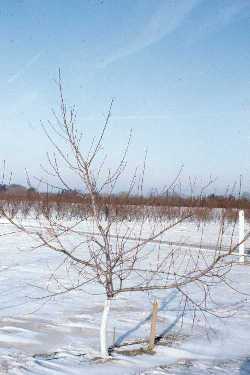
3. Central leader
- 201 trees per acre (18 x 12 feet) but can go slightly closer depending upon equipment
- Labour efficient — less ladder work for pruning, thinning and harvesting
- Slightly greater yields per acre in the early years
- Steady yields overall 10–12 tons per acre
- Orchard longevity (13–18 years)
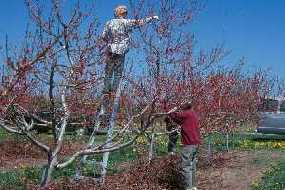
4. Fusetto
- 777 trees per acre (14 x 4 feet) but can go slightly farther apart
- Labour efficient — less ladder work for pruning, thinning and harvesting
- Greater yields per acre in the early years (good tonnage in second year)
- Greater annual yields per acre
- Short orchard life (8–12 years)
- Can adapt mechanical harvesting aids
- Slightly smaller fruit size
- Must irrigate and avoid any stress on the plant
5. Tatura Trellis, Kearney V and other systems
- High density
- Labour efficient — less ladder work for pruning, thinning and harvesting
- Greater yields per acre in the early years (good tonnage in second year)
- Greater annual yields per acre
- Short orchard life (8–12 years)
- Can adapt mechanical harvesting aids
- Extra costs involved for trellis
- Must irrigate and avoid any stress on the plant
Cultivars and rootstocks
Recommended peach and nectarine cultivars
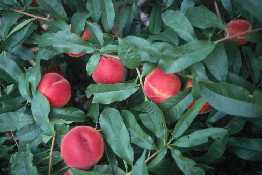
The average dates of the first commercial harvest of the listed cultivars are from the University of Guelph, Department on Plant Agriculture, Vineland. These dates are derived from observations over many seasons; actual harvest dates will vary from season to season and location to location. The harvest dates provide a guide for growers to select cultivars that ripen in sequence over the entire fruiting season and for shipper/dealers in marketing the fruit.
See the ripening chart in the fact sheet Peach and nectarine cultivars.
For photos of peach and nectarines cultivars, see the Tender Fruit Photo Gallery.
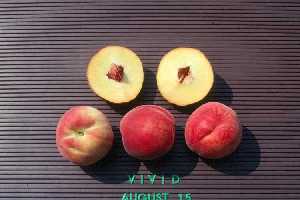
Pollination
Peaches and nectarines are self pollinated so you can plant in solid blocks. Growers generally plant a more than one cultivar for labour considerations during harvest.
Peach rootstock descriptions
Over the years, the availability of large quantities of seed of particular cultivars (Lovell, Elberta and Halford) from the peach processing industry has dictated the seedling used as a peach rootstock in North America. Research findings over the past 20 years have favoured the use of one rootstock, Bailey.
Bailey - An old peach cultivar released from West Branch, Iowa at the beginning of the present century. Bailey is a very hardy peach which produces small, white- fleshed, freestone fruits having no commercial culinary value. Pits germinate readily and are compatible with recommended scions. Cultivars budded to Bailey seedlings develop into uniform trees that are medium to large in size.
This rootstock has been reported to confer some degree of cold hardiness on some scion cultivars. In addition, tree survival on this rootstock has been good after severe winters. Bailey is considered to be one of the best rootstocks currently available and is recommended for peaches in Ontario.
Planting, nutrition and early management
Pre-plant year
- Tile drainage every row to reduce any standing water
- Soil testing prior to planting to correct any nutrient deficiencies
- Soil pH 6.5 , add lime if too low
- Fumigate for root lesion and dagger nematodes where necessary
- Build up organic matter from cover crops or other soil amendments
Planting year
- Use quality, insect and disease free (crown gall, canker, Plum Pox Virus)
- 9/16 to 11/16 inch caliper, a small tree will never catch up
- Use tree auger for precision (scar edge of hole) and tree planter for volume
- Delay pruning after planting to see what is dead or alive
- For central leader;
- head tree at 4 feet, remove branches 12 inches from leader,
- leave 7–9 well spaced branches (extra branches into the prevailing winds),
- remove any branches below 2 feet
- Do not fertilize
- Summer prune 4 weeks after spring pruning to remove any dead stubs, remove competition with the leader and any aggressive upward shoot
- Irrigate
- Pre-plant herbicides and mechanical weed control, carefully use paraquat if you have too, no glysophate
- Apply annual ground cover, annual rye grass with light fertilizer
- Fall paint and or tree guards with mouse bait
2nd Leaf
- Spring pruning at pink bloom stage or later to reduce leucostoma canker injury
- For Central Leader Training;
- Select the strongest leader into the wind,
- Reduce by 1/3 if growth was excessive (over 3 feet),
- Remove all branches 12 inches from leader,
- Leave 6-8 well spaced scaffold branches at a 60° angle to the leader (extra branches into the prevailing winds),
- Scaffold branches should be ½ to 1/3 the size of the central leader,
- Allow horizontal side branches off the scaffold branches ½ to 1/3 size of the scaffold branch.
- Fertilize 1/8 lb. (40 grams per tree) of actual N, approximately 1/4 lb. (100 grams) of Muriate of Potash
- Use leaf analysis for all nutrient recommendations for following years
- Summer prune 4 weeks after pruning to remove competition from leader and any aggressive upward shoots
- Remove any green fruit in favour of growth
- Can use early season analysis to correct current season's nutrient deficiencies
- Irrigate
- Pre-emergent herbicides and mechanical weed control, carefully use paraquat, no glysophate
- Apply annual ground cover, annual rye grass with light fertilizer
- Mouse bait if high pressure
3rd Leaf
- Spring pruning at pink bloom stage or later to reduce leucostoma canker injury
- For Central Leader Training;
- Maintain and direct the leader into the wind,
- Reduce by 1/3 if growth was excessive (over 3 feet),
- Remove all branches 12 inches from leader,
- Leave 5–7 well spaced scaffold branches at a 60° angle to the leader (extra branches into the prevailing winds),
- Scaffold branches should be ½ to 1/3 the size of the central leader,
- Allow horizontal side branches off the scaffold branches 1/2 to 1/3 size of the scaffold branch.
- Select 4–5 new branches for an upper, renewable fruiting tier
- Fertilize 1/4 lb. (80 grams per tree) of actual N, approximately 1/2 lb. (200 grams) of Muriate of Potash
- Use leaf analysis for all nutrient recommendations for following years
- Summer prune 4 weeks after pruning to remove competition from leader and any aggressive upward shoots
- Thin green fruit and allow tree to crop if growth is good, 20–30 lbs.
- Can use early season analysis to correct current season's nutrient deficiencies
- Irrigate
- Pre-emergent herbicides and carefully use paraquat, no glysophate
- Apply annual ground cover, annual rye grass with light fertilizer or establish permanent sod, creeping red fescue
- Mouse bait if high pressure
4th Leaf
- Spring pruning at green tip to pink bloom stage or later to reduce leucostoma canker injury
- For Central Leader Training;
- Maintain and direct the leader into the wind,
- Reduce by 1/3 if growth was excessive (over 3 feet),
- Remove all branches 12 inches from leader,
- Leave 4-6 well spaced permanent scaffold branches at a 60° angle to the leader (extra branches into the prevailing winds),
- Scaffold branches should be 1/2 to 1/3 the size of the central leader,
- Allow horizontal side branches off the scaffold branches 1/2 to 1/3 size of the scaffold branch.
- Head Back or select 4–5 new branches for an upper, renewable fruiting tier
- Use leaf analysis for all nutrient recommendations for following years
- Summer pruning only if necessary to reduce shading in middle of tree
- Thin green fruit and allow tree to crop, 40-60 lbs.
- Can use early season analysis to correct current season's nutrient deficiencies
- Irrigate
- Pre-emergent herbicides and carefully use paraquat and or glysophate
- Permanent sod, creeping red fescue
- Mouse bait if high pressure
5th Leaf
- Spring pruning at green tip to pink bloom stage or later to reduce leucostoma canker injury
- For Central Leader Training;
- Maintain leader at 14 feet, select weaker alternate if necessary
- Maintain 4–6 well spaced permanent scaffold branches at a 60° angle to the leader (extra branches into the prevailing winds),
- Scaffold branches should be 1/2 to 1/3 the size of the central leader,
- Head back scaffold branches into the tree row and between trees
- Head back or select 4–5 new branches for an upper, renewable fruiting tier
- Use leaf analysis for all nutrient recommendations for following years
- Consider split applications of Nitrogen (50% April, 50% June) for plant efficiency
- Thin green fruit (6–8 inches apart) and allow tree to crop, 80-100 lbs.
- 300 peaches per tree (at 3 peaches per lb.) = 100 lbs. per tree x
- 100 lbs. per tree x 200 trees per acre = 10 tons per acre
- Can use early season analysis to correct current season's nutrient deficiencies
- Irrigate early season, do not play catch up
- Pre-emergent herbicides and carefully use paraquat and or glysophate
- Permanent sod, creeping red fescue
- Mouse bait if high pressure
Harvesting and grading
Processing
- Hand harvest in two picks for most years, 3 to 5 days apart
- Can delay harvest until fruit is a full round with golden background colour
- Fruit will hang on the tree for extended periods without fruit drop (except later season and especially Babygold 7
- Growers need to consider earlier harvest in case of forecasted rains or extreme heat
- Peaches are normally harvested in 11 quart waxed lugs, field graded while harvesting and gently poured into plastic bins
- Full bins are normally removed from the field heat as soon as possible and put either into the shade of a barn or straight into a cold storage at 0–1° C (32–33° F)
- Bins are delivered to processor same day as harvest
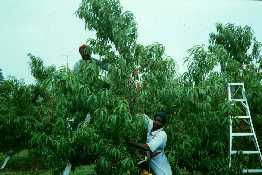
Fresh market
- Hand harvest in four picks for most years, 2 to 3 days apart
- Can delay harvest until fruit is almost full round with golden background colour but still firm to the touch. Do not harvest when peach is flat sided with a green background.
- Growers need to consider earlier harvest in case of forecasted rains or extreme heat
- Peaches are normally harvested in 11 quart waxed lugs and shortly there after removed from the field and put straight into a cold storage at 0–1° C (32–33° F)
- Once the field heat has been removed, fruit is typically size graded, and culls removed. The fruit is sorted into two or three types of packages depending upon market and then delivered to the shipper/dealer
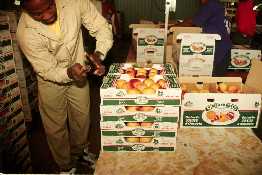
Insects and disease
Major pests
Insects
- Oriental Fruit Moth, Tarnished Plant Bug, European Red Mite and Two Spotted Mite, Aphids, Peach Tree Borer
Diseases
- Plum Pox Virus (Sharka), Brown Rot, Bacterial Spot, Peach Canker, Peach Leaf Curl